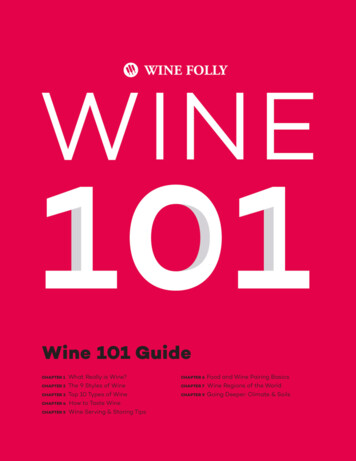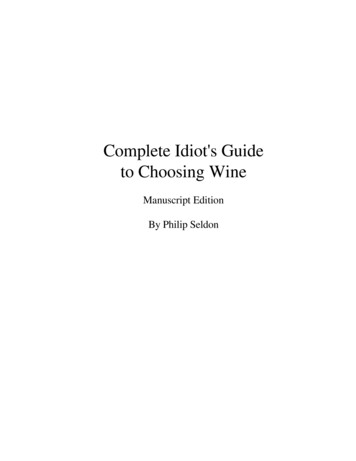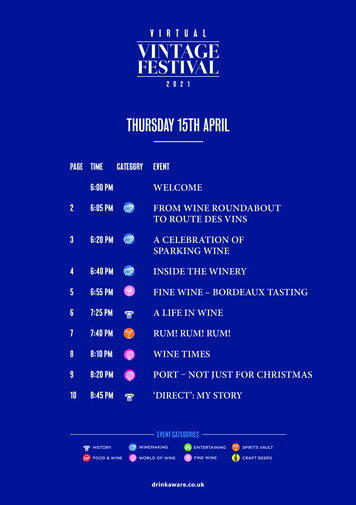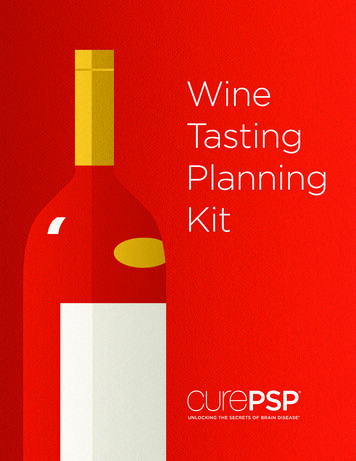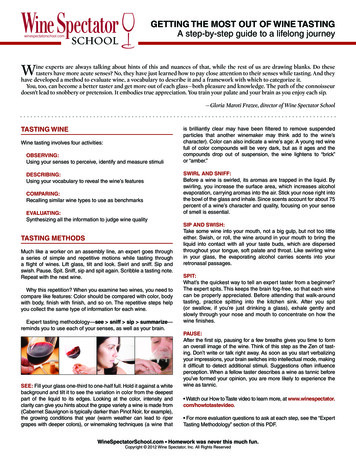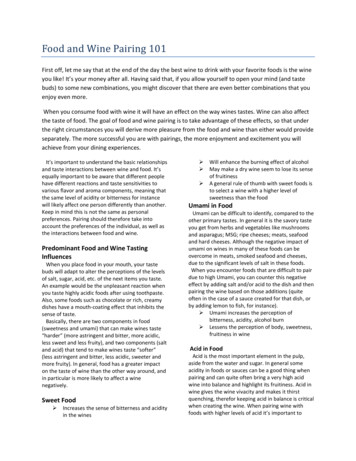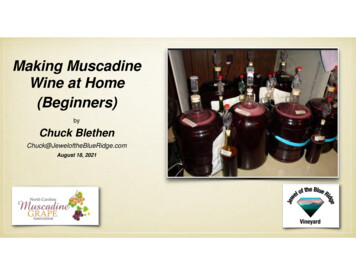
Transcription
Making MuscadineWine at Home(Beginners)byChuck BlethenChuck@JeweloftheBlueRidge.comAugust 18, 2021
American GrapesFox Grape(Vitus labrusca)CayugaRiverbank/Frost Grape(Vitus riparia)Muscadine/Scuppernong(Vitis rotundifolia)NiagaraCatawba & IsabellaConcordNorton/Cynthiana
Outline of this Muscadine Home Winemaking classLegal stuffSupplies neededBasic testing equipment you needSome useful charts/tablesUnique things you need to know about MuscadinesUseful referencesYou will learn a little basic chemistry and zymology
The purpose of this class is to“Teach you how to make Muscadine wine at home”In short - learn how to manage fermentationFermentation stops at 14.5%
How much wine can I legally make?The U.S. Law Concerning Alcohol ProductionBATF Sec. 24.75Wine for personal or family use(a) General. Any adult may, without payment of tax, produce wine for personal or family use and not for sale.(b) Quantity. The aggregate amount of wine that may be produced exempt from tax with respect to anyhousehold may not exceed:(1) 200 gallons per calendar year for a household in which two or more adults reside, or(2) 100 gallons per calendar year if there is only one adult residing in the household.(c) Definition of an adult. For the purposes of this section, an adult is any individual who is 18 years of age orolder. However, if the locality in which the household is located has established by law a greater minimumage at which wine may be sold to individuals, the term ”adult” will mean an individual who has attained thatage.This was last updated on September 17, 1999 (verified 2020)Note: You can make alcohol, but you can’t concentrate it(Make grappa without a license)
What factors impact the quality of wine made at home?Quality of your material sourceSanitation levelAbility to test/taste your wineAbility make necessary adjustments of acidity, sweetness, residual sulphite, etc.Your winemaking skills
SuppliesGlass carboys - 1, 2, 3, 5 or 6.5 gallonsMeasuring spoons and cups
SuppliesAirlocks
SuppliesWine bottles(new or recycled)CorksBuy the best quality you can get
SuppliesCorking Machine - for a few bottles
SuppliesFloor/TabletopCorking Machine(for dozens of bottles)
SuppliesYeasts (dry or liquid)Toasted oak chips (or oak powder) – adds oak flavor to winePotassium MetaBi-sulphite – kills rogue yeasts in the must & preserves wineDextrose or Simple sugar – to increase the potential alcohol in Muscadine juiceYeast Energizers/Nutrients
Testing EquipmentHydrometer & Graduated Cylinder
Testing EquipmentPlace 1 dropof juice hereRefractometer
SG/Brix/PA Conversion Chart
Testing EquipmentTitratable Acid (TA) Test Kit - follow directions
Adjusting the Acidity of your wine(0.60 to 0.80 TA)To obtain 6 g/L add to eachgallonTo obtain 8 g/Ladd to eachgallon(g/L*)(g) - oz(g) - oz3.011.3 0.3918.9 0.663.59.4 0.3317.0 0.604.07.5 0.2615.2 0.534.55.6 0.1913.2 0.465.03.8 0.1311.4 0.405.51.9 0.669.5 0.33Total Acidity(TA)6.07.5 0.266.55.6 0.197.03.8 0.137.51.9 0.66* Titratable acid as tartaric acid - TA test kit value x 10
Clean & sanitize EVERYTHING – bottles, glasses,corks, tubing, caps, stirrers, carboys, hands –anything that may come in contact with the wineKeep unwanted (rogue) bacteria, mold and fungusfrom growing in your wineOnly the yeast / bacteria that you CHOOSE forfermenting your wine to be allowed to thrive & grow
Supplies for Cleaning/SanitizingIodophor sanitizer only – youstill need a cleaner soap & water)OneStep (cleaner &sanitizer)One tbsp per gallonof warm water25 minutes soakKMS(PotassiumMetabisulphite sanitizer only –you still need acleaner)Two caps/5 gallonsTwo oz./ gallonof water60 second soak20 second soakWorks great ina spray bottletoo!
Winemaking EquipmentGrape CrusherPress bag (a.k.a. jelly bag)Wine Press
Common clarifiers used by home winemakersto “fine” or “clarify” hazy or cloudy winesEgg albumen (egg whites) Time /Refrigeration /-Gelatin Super-Kleer (Kieselsol/Chitosan (shellfish)) -Isinglass (fish scales) Activated CarbonCasein and caseinates Crushed egg shellsChitosan (chitin) Diatomaceous earthSparkolloid Polyvinylpyrrolidone (PVP)Enolophin / Kieselsol -PolyclarBentonite clay -Milk (2-3 drops per gallon)
Sulfites for Wine PreservationUsed in winemaking over 100 yearsWine yeast produce small amounts of SO2 during fermentationGood winemaking practices call for adding 50 to 100 ppmAt bottling time residual sulphur dioxide is 30 to 50 ppmUS regulations require warning on labels (Contains Sulphites)for wines containing more than 10 ppm sulphur dioxideAbout 10% population at large allergic to sulphites
Testing EquipmentFree Sulphite Test Strips - follow directions
Free sulphites in wine is highly dependent upon pH
SuppliesRacking (siphoning) is necessary skillto develop if making wine at homeAuto-Siphon
Origin of Wine Aromas (smell)
Unique Things You Need To Know AboutMuscadine WinemakingScuppernongs were used to make the first American wine the thecolonies in the early 1500sModern researchers call muscadine the “smart grape”Dwell time on the red muscadine skins is a few hours - NOT days/weeksHas high acid naturallyReady to bottle in 6 months
The Nature of Muscadine GrapesThicker skinsHigh in aromatic polyphenolsLow natural sugar contentLow to no tanninLow pHMedium to High TAHigh Ellagic Acid contentLower nitrogen contentHigh tendency to oxidizeHigh level of ResveratrolMedium level of proteinsHigher disagreeable polyphenols in seedsRipening over an extended period of time (multiple harvests)
Balanced Muscadine WinemakingBodyResidualSugarAlways adjust alcohol potentialbefore pitchng yeastTotalAciditypHMonitor TA & pHTaste from time to time
Balanced Muscadine WinemakingRemember:Relatively small changes in added sugarchanges the aromatic profile significantly
Muscadine Home Winemaking Equipment & SuppliesEquipment needed: Primary Fermenter. A 6-8 gallon bucket with a lid would be preferable - food grade plasticSecondary Fermenter. A 5 gallon narrow-necked carboy, preferably glassAirlock. To allow carbon dioxide gas to escape and keep out air. Fill and keep full with sterilizing agentSiphon. 6 feet of food grade plastic tubing or Auto-SiphonSmall crusher. - to break the skins of the grapesStrainer. Either cheese cloth or a nylon bag (or small wine press)Supplies: Wine Yeast - One packet of EC-1118 or Lalvin RC 212 (Scott Labs W15 works well too)Campden tablets - This kills off wild bacteria and yeast found on the fruit skins; acts as preservative in bottlesGrapes - 90 pounds to yield 5 gallons of wineYeast Nutrient - Lallemand Fermaid O works best.Simple Sugar* - Turbinado sugar works the best for home winemaking (boil water and sugar, then cool before using)Non-chlorinated water*Simple Sugar is turbinado sugar mixture 1:1 with water that has been boiled and cooled
Ready to go!
Muscadine Wine Recipe - (5 Gallons)Pick or buy your grapes. Ripe Muscadine grapes have a sugar level of about 14-16 Brix.Directions:1 - For white muscadines immediately crush & press the grapes to remove the grape skins, pulp and seeds and pour juice into acarboy. Measure the Brix to determine how much sugar to add to bring the potential alcohol up to 10-11%. Next, slowly stirsimple sugar* into the must making sure hydrometer reading does not go higher than 1.085 (20 Brix). Multiply the Brix readingby 0.57 to get potential alcohol. If you have an acid test kit at home, test your wine and adjust it accordingly at this point.You need a Total Acidity (TA) of about .60 to .80. Add tartaric acid if TA too low, and potassium bicarbonate if TA is toohigh. Mix yeast nutrient with 1-2 packets of wine yeast in a cup of warm water and add to must. Primary fermentation willbegin. Seal/cover fermenter.2. For red muscadines, crush the grapes into a primary bucket and cover. Wait for 4-6 hours, before pressing the grapes toremove the grape skins, pulp and seeds. Then slowly stir simple sugar into the must making sure hydrometer reading does notgo higher than hydrometer 1.085 (20 Brix) If you have an acid test kit at home, test your wine and adjust it accordingly atthis point. You need a Total Acidity (TA) of about .60 to .80. Add tartaric acid if TA too low, and potassium bicarbonate if TAis too high. Mix well. Mix yeast nutrient with 1-2 packets of wine yeast in a cup of warm water ( 110F) and add to must.Primary fermentation will begin. Pour juice into a carboy and seal with an airlock.3. Let the wine ferment/age for 6 months.4. Make a final check of the TA and taste test. Make any sweetness/acidity adjustments prior to bottling.5. Dissolve 1 crushed Campden tablet in a small cup of water and add to carboy6. Bottle and cork - Ready to drink now but tastes better if you can wait about 6 months.*Simple Sugar is turbinado sugar mixture 1:1 with water that has been boiled and cooled
Storing your Muscadine WineStore your wine in a place that is:DarkCool (55-65FFree of vibrations
Aging Your Muscadine WineMuscadine wines are best when they are consumed young6 months to a year
Some of my References
My Winemaking Supply SourceAsheville Brewers Supply (supplies/kits)712 Merrimon AveAsheville NC 28804(828) 285-0515www.AshevilleBrewers.com
Music: Drinkin’ Wine by Jerry Lee LewisMaking Muscadine Wineat HomeThanks for watching Cheers!
simple sugar* into the must making sure hydrometer reading does not go higher than 1.085 (20 Brix). Multiply the Brix reading by 0.57 to get potential alcohol. If you have an acid test kit at home, test your wine and adjust it accordingly at this point. You need a Total Acidity (TA) of about .60 to .80.

